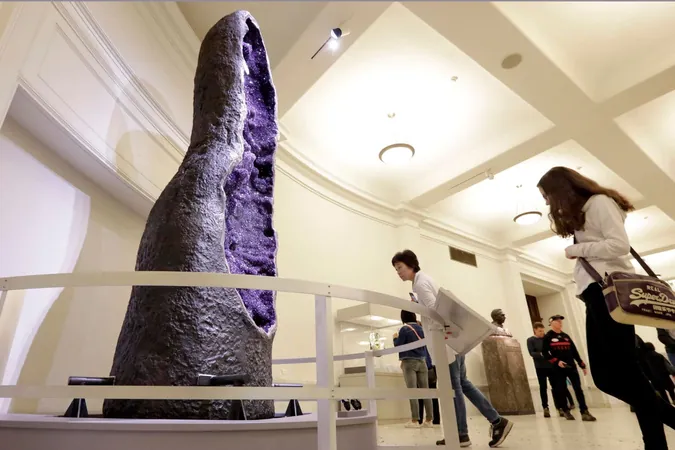
The Astonishing Discovery Behind the Magical Giant Amethyst Geodes!
2024-10-09
Author: Michael
Introduction
Scientists have recently unlocked the secrets of the giant amethyst geodes found in the Los Catalanes District of Uruguay, revealing groundbreaking insights into their formation. This captivating discovery, made possible through meticulous geological surveys and sophisticated chemical analyses, has stunned researchers around the globe.
The Los Catalanes District
The Los Catalanes District is famous for its deep violet-colored amethyst gems, often regarded as the crème de la crème in the gem world, and the massive amethyst geodes, some towering over 16 feet (5 meters) high. These geodes not only dazzle with their breathtaking beauty but are also recognized as one of the world's premier geological heritage sites, underscoring their immense scientific and natural significance.
How Giant Geodes Form
But how do such colossal geodes form? Traditionally, it was understood that geodes developed inside small gas bubbles in lava rocks. However, the formation of these giant structures has remained a tantalizing enigma—until now. The geodes in Uruguay’s unique geological landscape originate from the remnants of the supercontinent Gondwana, which began breaking apart approximately 134 million years ago.
Geological Surveys and Discoveries
After the initial lava flows solidified, silicon-rich fluids began circulating through the rocks, leaving behind stunning layers of silicon-dioxide quartz crystals within volcanic cavities. The iconic violet hue of these amethyst crystals comes from traces of iron, but the scale of the geodes posed an intriguing challenge to geologists.
A research team from Göttingen University conducted exhaustive geological surveys across 30 active mines in the region and made an extraordinary revelation. Their findings showed that the geodes formed at surprisingly low crystallization temperatures—between 15 to 60 degrees Celsius—thanks to a steady flow of groundwater. They also found that the mineral-rich fluids had low salinity levels, indicating a connection to rainwater that replenished the groundwater table.
Research Insights and Future Implications
Lead researcher Fiorella Arduin Rode stated, "The precision and accuracy of our new techniques allowed us to confidently estimate the temperature and composition of the mineralizing fluids." This research not only underscores the unusual conditions under which these crystals form but also offers a fresh perspective on the processes that lead to such grandeur.
The study proposes a novel model describing the genesis of these enormous geodes. As rainwater seeps through thick lava deposits, it gradually dissolves the rocks beneath. An impermeable underground layer causes the iron- and silicon-rich fluids to ascend toward existing cavities near the surface. The combination of the relatively low and stable temperatures along with a consistent supply of minerals results in the formation of multiple layers of quartz, chalcedony, and, of course, stunning amethyst crystals.
Conclusion
Rode emphasized the importance of understanding the conditions surrounding amethyst formation, stating, "This knowledge is crucial for unraveling the mineralization process. It could lead to improved exploration techniques and establish sustainable mining practices in the future."
This exciting study, titled “World-class amethyst-agate geodes from Los Catalanes, Northern Uruguay: genetic implications from fluid inclusions and stable isotopes,” was published in the esteemed journal *Mineralium Deposita*. With these revelations, the world may not only witness the enchanting beauty of the Los Catalanes geodes but also appreciate their complex geological story that stretches back millions of years!









 Brasil (PT)
Brasil (PT)
 Canada (EN)
Canada (EN)
 Chile (ES)
Chile (ES)
 España (ES)
España (ES)
 France (FR)
France (FR)
 Hong Kong (EN)
Hong Kong (EN)
 Italia (IT)
Italia (IT)
 日本 (JA)
日本 (JA)
 Magyarország (HU)
Magyarország (HU)
 Norge (NO)
Norge (NO)
 Polska (PL)
Polska (PL)
 Schweiz (DE)
Schweiz (DE)
 Singapore (EN)
Singapore (EN)
 Sverige (SV)
Sverige (SV)
 Suomi (FI)
Suomi (FI)
 Türkiye (TR)
Türkiye (TR)